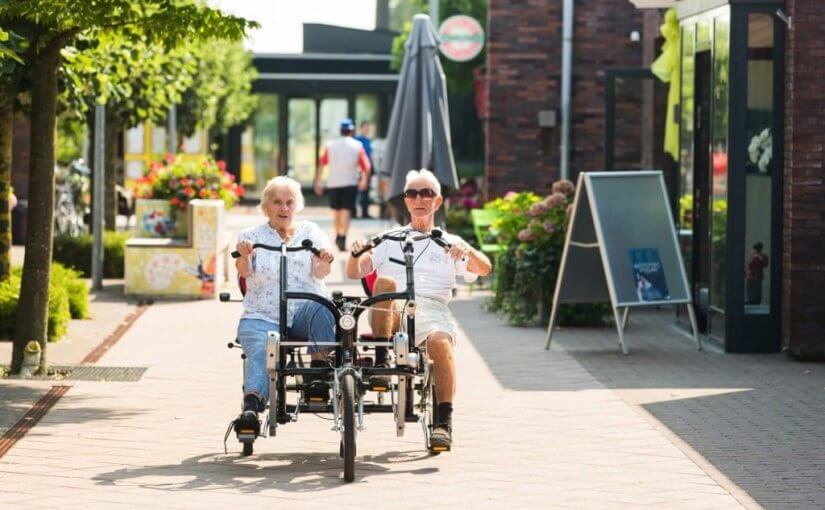A friendly tour of dementia care villages in Europe (including the UK) and North America—plus practical tips for families.
Picture this: your loved one with dementia heads out the front door, waves to a neighbour, wanders through a leafy garden, then stops for a coffee at the café on the corner. It feels like an ordinary neighbourhood. But here’s the twist—it’s also a safe, carefully designed community where dementia care is woven seamlessly into daily life.
These are dementia villages. Instead of hospital-like care homes, they offer small households, shared spaces, gardens, and even shops or hair salons. Staff often dress in everyday clothes and blend into community life. The idea first took root in the Netherlands and has since spread to France, the UK, Denmark, Canada, and the US. Each has its own style, but the mission is the same: keep life life-like.
Let’s take a gentle tour of some of the most talked-about dementia villages across Europe and North America.
The pioneers & the fan favourites
The Hogeweyk (Weesp, Netherlands)
This is the one that started it all. Opened in 2009, The Hogeweyk is often called the “dementia village” prototype. It has more than 23 small households clustered around a town square with a theatre, café, and grocery store. People live in homes based on lifestyle preferences—like “urban” or “cultural”—so surroundings feel familiar. Many families who’ve visited say it feels like a real village, not a care facility.
Village Landais Alzheimer (Dax, France)
France joined the movement in 2020 with its own version, designed for about 120 residents. The architecture is colourful, inviting, and intentionally avoids anything “clinical.” Residents can visit shops, stroll courtyards, and enjoy cultural activities with support nearby when needed. It’s designed to encourage autonomy while keeping safety in mind.
Belong Villages (various towns, UK)
Across England, Belong operates several “villages” that combine households with community hubs like bistros, gyms, and salons. They don’t replicate a walled-off town like Hogeweyk, but the philosophy is similar—life continues in familiar rhythms, with care wrapped around it. Families in places like Crewe or Chester often describe them as lively neighbourhoods where everyone’s included.
Svendborg Demensby (Svendborg, Denmark)
Denmark opened its first dementia village in 2016, with homes set around shared spaces like a library, shops, and a café. Meals are often cooked in-house, and residents can take part in daily routines. Like many Scandinavian approaches, it blends practical design with warmth and social life.
The Village Langley (British Columbia, Canada)
Canada’s first purpose-built dementia village opened in 2019. Spread across about 5–7 acres, it features cottage-style homes, walking paths, gardens, and even farm animals. Families who’ve visited describe it as a place where people can safely wander outdoors and connect with nature. It’s private-pay and can be costly, but it’s a landmark for dementia care in North America.
Glenner Town Square® (San Diego County, USA) – day program
This one’s a little different. Glenner Town Square isn’t residential—it’s a day program built like a 1950s main street, complete with a diner, movie theatre, and barber shop. The vintage theme sparks memories and conversations, offering social engagement and respite for caregivers during the day.
The Lantern (Ohio, USA) – assisted living with a twist
The Lantern communities in Ohio use streetscapes and vintage design indoors to mimic small-town life. It’s not a full outdoor village, but the idea is the same: orient people with familiar cues and reduce anxiety through environment.
What these places have in common
- Small households instead of big wards, so people live around a kitchen table, not a nurses’ station.
- Everyday routines—from gardening to grabbing a coffee—become the therapy.
- Staff blend in with daily life, often wearing aprons instead of scrubs.
- Safety is built in with secure perimeters and clever design, so residents can move freely without constant reminders of what not to do.
Thinking about a dementia village for your loved one?
- Match the model to the person. Villages are best for people who still enjoy being active—walking, chatting, or gardening. Someone needing quieter, low-stimulation care may do better in a smaller household, even inside a village.
- Tour with your senses. Notice the smells, sounds, and atmosphere. Do you smell home cooking? Hear laughter? See people involved in activities? That’s a good sign of authentic daily life.
- Ask about staff and training. The most beautiful setting won’t help if staff aren’t trained in dementia care approaches like validation and de-escalation.
- Be clear on costs. In Canada and the US, dementia villages can be expensive—The Village Langley has reported rates in the CAD $8,000–$10,000/month range. Always ask what’s included.
- Look for family involvement. The best communities encourage families to join meals, activities, and everyday life, not just visit.
- Focus on philosophy, not branding. Some excellent dementia-friendly communities don’t call themselves “villages.” What matters most is whether your loved one feels at home.
Quick links
- The Hogeweyk (Netherlands): hogeweyk.dementiavillage.com
- Village Landais Alzheimer (France): villagealzheimer.landes.fr/en
- Belong Villages (UK): belong.org.uk
- Svendborg Demensby (Denmark): overview article
- The Village Langley (Canada): verveseniorliving.com/the-village
- Glenner Town Square® (USA, day program): glenner.org/town-square
- The Lantern (USA): lanternofmadison.com/dementia/index.htm
Did You Know?
Memo24 pill reminder service is an automated phone call reminder service, it is used around the world to help the elderly live a more independent life at home.
Memo24 is simple to set up and affordable, with no subscription and no hidden fees.
